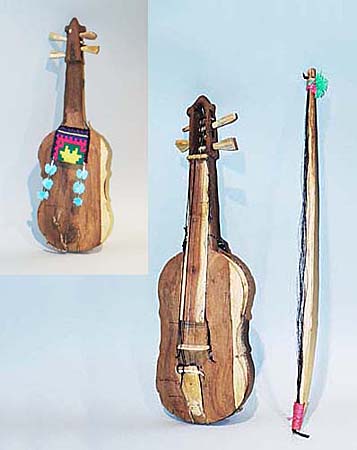
Owner: HWMC
Catalog#: 2LA-CHLT-01
Lutes
Huichol ‘Raweali’ (Violin)
West Central Mexico
Huichol People
Cottonwood, metal strings, horse hair, cotton fiber
Mid-20th century
Length: 19 in; Width: 6 in; Depth: 1.25 in
Chordophones – Lutes
When the Spanish arrived in the 16th century, they brought with them the rabel, a rustic folk-fiddle descended from the medieval rebec. The native people of Mexico took to this more eagerly than the authorities had expected and by 1555 it was considered a disruptive influence and was banned throughout New Spain. This naturally had the opposite effect intended, and in rural areas native versions of the fiddle continued to thrive and diversify into various regional forms.
This rawali comes from the Huichol native people of west central Mexico. It is made of white cotton wood and has two horsehairs and two metal strings. A crocheted pouch with geometric patterns, and two decorative dangles (pompoms) is attached to the neck of the instrument. The bow that goes with this instrument is also made of cottonwood with horsehair. The horsehair is held on with pink yarn, and at one end of the bow a light green pompom is tied on as well. The raweali is used in magical rituals, and legend has it that it came to them direct from Santo Cristo (the Divine Christ), who won a fiddle contest using the instrument.
Resource: Mexican Fiddle (fiddlingaround.co.uk)
